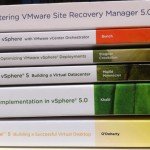I’ve got the opportunity to read one new book about the Horizon View solution: VMware Horizon View Essentials from Peter von Oven (the co-author of other VMware Horizon books, like VMware Horizon Workspace Essentials).
This book is not from VMware Press, but from a different editor, that is Packt Publishing and has several interesting books (really a lot on virtualization and still growing) and actually has several interesting authors (and reviewers) for those books from the VMware’s community.
The Packt’s Essentials series has a specific learning pathway and level: fast paced, concentrated introductions showing the quickest way to put the tool to work in the real world.
 The declared target of this book is a desktop administrator or an end user of a computing project team looking to speed up to the latest VMware Horizon View solution, then this book is perfect for you. It is your ideal companion successfully design, install, and configure an end-to-end VDI infrastructure with VMware Horizon View.
The declared target of this book is a desktop administrator or an end user of a computing project team looking to speed up to the latest VMware Horizon View solution, then this book is perfect for you. It is your ideal companion successfully design, install, and configure an end-to-end VDI infrastructure with VMware Horizon View.
This book cover the latest version of VMware Horizon (with View) product, and is based on version 6.0 with a step-by-step approach: starting from an product overview (including an architectural overview), going to the design and installation part, then to the operational part.
Maybe a different order was (in my opinion) better for the declared book targets: by keeping the architectural design and the installation and configuration of the infrastructure after the introduction and the operational part (and the design part related to desktops and other resources).
The first chapter give a short but great overview of VDI (or hosted virtual desktop model) and server-based computing (both for published applications or desktop sessions) explaining also the difference between those models. There is also place for an history of VMware VDI solutions and a comparison of existing Horizon editions.
The second chapter give a detailed architecture overview of VMware Horizon for View and how does it work, using also some simple and clear schemas, diagrams and pictures. This chapter is a must of each View admins to be use to understand all the different components, technologies and how they interact together.
The third chapter is about how design and build the infrastructure and is a must of each View architect (or for people the would like to prepare the VCAP-DTD exam) giving also the right approach of implement those kind of solutions starting from a PoC. But the best part is how design those kind of infrastructures starting with the pod and block reference architecture (including a multi-datacenter architecture). Curios the sizing and the requirements part reports, for some components only Windows Server 2008 R2, where also the 2012 R2 was supported (this was one of changes in the 6.0 version).
The fourth chapter is about the installation part, but it’s more than the official View guides, for example it starts from the Root CA server that is a very important part in a View infrastructure where SSL certificates are widely used. And this chapter is based on a pragmating and procedural approach easy to follow, use and apply.
With chapter five starts the part related to the product usage with an overview of the administrator console and how building and optimizing virtual desktop machine OS images (chapter 6) and how configuring Horizon View to deliver virtual desktops (chapter 7), Horizon View clients including Blast access (chapter 8) and how provide fine-tuning for the end user experience (chapter 9).
At this point seems that something is missing: ThinApp, remote applications, VSAN, backup, data protection, site disaster recovery are not really covered and it’s a pity because the book quality is really high and was nice have a single resource for all the View related stuff.
Also there aren’t user cases or specific real examples on how use this kind of product (but I don’t see this as a big limit like the lack of some parts).
So this book give a great overview of the product and its architecture, with a clear approach going from the installation to the configuration and usage. In my opinion is not only for end users or admins, but also for designer and architects and could be a great resource also for VCP-DT or View’s related VCAP preparation.
By giving a more complete coverage and a different order of the chapters probably was the best book about View. Anyway actually it is probably the best because there are only few resources available for the version 6 of Horizon View.



